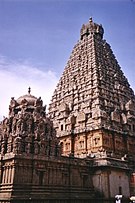Education in ancient Tamil country
| Part of a series on |
| History of Tamil Nadu |
|---|
 |
| Part of a series on |
| Sri Lankan Tamils |
|---|
| Part of a series on the |
| History of Kerala |
|---|
Education was considered important in Ancient
Tamil as they considered the mind of the uneducated to be an "abode of darkness". The sangam period of acquiring knowledge was during youth.[1][2]
The rulers and aristocrats of ancient
Naladiyar one of the Tamil books of Law lauds that "men gathered books in abundance and filled their house with them." They studied science, mathematics, engineering, astronomy, logic and ethics.[4][5]
Education was widespread and there was high standard of literacy. Libraries attached to Jain Pallis and Buddha Viharas promoted education among the people.[
Women and education
The girls of the Sangam age were given a good training in literature, music and drama. The Sangam literature bears ample evidence to the fact that many women had distinguished themselves in the art of music.[8]
More than fifty women have been ranked among the Sangam poets.[9]
Late Sangam age
The
The Five Great Epics of Tamil Literature were composed during this period. These epics broke with the Sangam convention of not mentioning the names or specific details of the characters, showing signs of growing influence from Sanskrit.[10]
Decline after Sangam age
Unlike the
Veda, the penalty was that molten lead was poured into his ears and a hot stylus be thrust in his tongue, respectively.[13]
References
- ^ Nadarajah, Devapoopathy (1969). Women in Tamil society: the classical period. Faculty of Arts, University of Malaya.
- ^ Object, object. "A History of Education in Tamil Nadu, India".
{{cite journal}}: Cite journal requires|journal=(help) - ^ Pillai, Suppaiah (1994). The Contributions of the Tamils to Indian Culture: Socio-cultural aspects. International Institute of Tamil Studies.
- ^ Subramanian, N. (1979). History of South India. S. Chand.
- ISSN 2717-7564.
- ^ Nair, Balakrishna (1994). Social development and demographic changes in South India: focus on Kerala. M.D. Publications Pvt. Ltd.
- ^ Kerala District Gazetteers: Trichur. Superintendent of Government Presses. 1962. p. 95.
- ^ Ci Pālacuppiramaṇiyan̲ (1976). The status of women in Tamilnadu during the Sangam age. University of Madras.
- ^ Jayapalan, N. (2000). Women studies. Atlantic Publishers & Dist, 2000.
- ^ Datta, Amaresh (2006). The Encyclopaedia Of Indian Literature (Volume Two) (Devraj To Jyoti), Volume 2. Sahitya Akademi.
- ^ Subrahmanian, N. (1989). The brahmin in the Tamil country. Ennes Publications.
- ISBN 9788173045615.
- ISBN 9788176481700.


